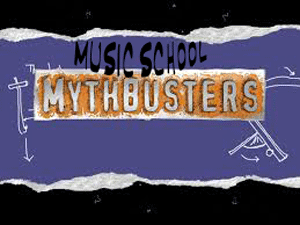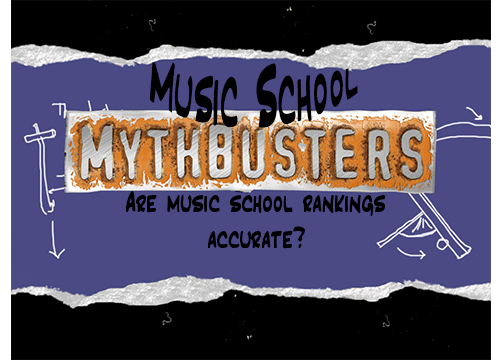Music School Mythbusters: Are Music School Rankings Accurate?
The Myth
It’s no secret that ours is an unusually competitive field. We face off regularly for chairs in orchestra, dream of becoming victorious in prestigious solo competitions, and constantly measure our playing by the standards of the greatest musicians. As a result, it is only natural that this competitive instinct be extended to what is possibly our greatest source of pride: the music school that we call home. We hear about the top conservatories and the invincible university programs, but with the advent of the information age, the ability to obtain access to these ostensibly formal rankings has become easier than ever. Now, a variety of music school rankings can be found in the eaves of the internet, posing significant implications for prospective students. While many of us have the opportunity to get the inside scoop on the merits of a particular institution from a trusted teacher or a close friend, others with little knowledge of the field may very well rely on such ranking lists to determine their choice of application, which raises a critically important question: are these music school rankings accurate? In this penultimate edition of Music School Mythbusters, we’re going to find out.
The Argument for the Myth
With rankings having an obviously profound impact on the choices of prospective applicants, one would assume that the individuals tasked with compiling such lists would surely do their homework before presenting what could be potentially controversial information. Thus, we can assume that these lists–at least, those published by a reputable publication–contain some degree of accuracy. One of these seemingly trustworthy sources is U.S. College Ranking.org, which ranks colleges of all types on an annual basis. Its latest ranking, released on December 21st of last year, listed the top ten music schools as follows:
1) Eastman School of Music
2) Juilliard School
3) Curtis Institute of Music
4) New England Conservatory of Music
5) Indiana University-Bloomington
6) University of Michigan-Ann Arbor
7) Northwestern University
8) Oberlin College-Conservatory
9) University of Cincinnati
10) University of Illinois-Urbana-Champaign
Now, given my status as a current Eastman student, I admit I am sorely tempted to do the snoopy dance when I see this particular list bandied about on social media. However, I am forced to restrain myself in view of basic common sense: it’s a heck of a lot harder to get into Curtis than it is to get into Eastman. According to collegeboard.org, Curtis’s acceptance rate for the 2012-2013 school year was 7%, whereas Eastman’s was 29%–still quite low, of course, but not nearly as low as its Philadelphia counterpart. So why did the folks over at U.S. News and World Report find it appropriate to place Curtis in the number three slot?
To investigate this apparent dilemma of numbers, I visited the “Ranking Methodology” section of the website. Here, the following criteria are listed, each with a corresponding percentage indicating its weight in the final ranking:
Teaching Quality / Professor Ratings (10%)
- Staff / Student Ratio (15%)
- Median Salary of Graduates (10%)
- SAT / ACT Test Scores (15%)
- Graduation Rate Performance (10%)
- Undergraduate Academic Reputation (20%)
- Student Selectivity (5%)
- Alumni (5%)
- Academic (Undergraduate) / Research (Graduate) Performance (5%)
- G-factor (5%) – Indicator of the popularity or importance of each university’s website from the combined perspectives of other institutions
Suddenly, Eastman’s ascendance to the no. 1 position seems to make perfect sense. The school is renowned for its emphasis on academics, which is given the highest weight amongst the above criteria. Similarly, Eastman is also widely recognized for its philosophy of developing the “whole” musician and preparing students for a variety of different music careers, from education to arts administration, which not only contributes to its inherent well-roundedness, but increases the probability that its graduates will be able to secure non-performance employment, in contrast to a school that perhaps did not encourage as much of a focus on alternative aspects of the field. Curtis, on the other hand, is the most exclusive performance institution in the world. Yes, it’s by and the large the hardest school to gain admission to, and its graduates usually go on to become stellar soloists, chamber musicians, and orchestra principals, but when those factors are only weighted at 5%, it’s not quite enough to push it to the top. The question remaining, then, is whether such criteria is fair, and it could be argued that in a certain sense, it is. The definition of an exemplary institution as accepted by the U.S. College Ranking.org is one that excels in all of these respects, and so when put to the test, Eastman rises to the top because it maintains rigorous standards both academically and musically. Within this context, therefore, we can assert that this ranking is accurate. The question addressed is, “What music school best fits the ideal implied by the given definition?” and the answer is arrived at in a thorough, calculated, and logical manner.
The Argument Against the Myth
However, while we can technically get away with the above argument, it’s more theoretical and less practical to rank music schools in such a manner, because nobody really perceives it that way. When music students and professionals discuss which school is of a higher level, they’re not thinking about things like the “Median Salary of Graduates” or “Graduation Rate Performance.” They’re simply thinking, do the kids play well or not? The common musician is almost always comparing schools in terms of the acceptance rate, and so there consequentially emerges a divide between what is perceived as the formal consensus and what musicians actually believe. While it’s certainly possible to form a general idea of what schools are at “the top,” it’s very difficult to do so objectively, because we all have different conceptions of what constitutes an ideal learning environment. Attempting to subsequently attach a number to the schools one has decided worthy of a “top ten” list only exacerbates the problem, and ultimately creates even more confusion.

“While the local gigging scene is somewhat lacking, the Europa Conservatory is unquestionably the best music school in the solar system.”
A perfect example of such a “subjective ranking attempt” can be found in a post on collegerag.net that appeared earlier this year, boldly entitled “Top 10 Best Music Colleges Known To Man.” Already, we have a red flag–“Known to Man”? What, is the author trying to imply that there might be some fantastic conservatory on Europa or something that we’ve yet to discover? The title is the least of our concerns, however, when we see which schools have made the cut and why. Eastman, in an unexpected twist, is now in the no. 10 spot, with the author lauding its Jazz and Opera programs and stating that since “Jazz is America’s best musical contribution to the world and is never to be taken lightly,” Eastman “has earned the respect and recognition of the music industry.” No mention of the strings department, which in my experience isn’t too shabby, or Eastman’s strong academic focus that brought it to the top in the U.S. College Ranking.org compilation. Next up is Oberlin, which according to the author “can be found in Ohio.” “Like most music schools, it is also required for the prospective student to audition first before being admitted,” the author continues. “Music schools are very strict in admissions and would only select the best and most qualified applicants in order to maintain and preserve their good reputation.” Aside from the tears issuing from my inner grammar-fanatic self, I find it incredulous that there’s not a single mention of Oberlin’s merits as a music school–which is significant, because as we go down the list, we discover that Curtis and Colburn are missing entirely! Yes, that’s right, Oberlin made the cut because they require auditions, but Curtis, you know, that’s just….probably a school the author didn’t know about, because they are clearly not a knowledgeable musician (or a journalist, for that matter). Yet, it is still live, it is still out there, and it can and will be read by prospective students who know little about the field, erroneously believing that it’s easier to get into Curtis than it is to Eastman and Oberlin. Yes, all of the schools on this list are great schools, but the manner in which they’re ranked (and the oh-so-cliched no. 1 designation to Juilliard) makes no sense whatsoever.
A quick Google search yields even more confusing results. Education Career Articles has a list that is particularly bizarre–while seemingly unranked, each school selected has a brief description accompanying it that, as in the collegerag article, is apparently intended to justify its inclusion. Bucknell University made the cut because “music majors are offered scholarships.” Furman University is also included because of “The Maxwell Music Library.” Juilliard, as usual, has found a place here, but only because of “The Juilliard Manuscript Collection.” Again, we have a perfect example of seemingly random criteria utilized to create a list almost entirely different from the most reliable example of U.S. College Ranking.org!
The Conclusion
The only reasonable conclusion we can draw from these wildly divergent rankings is that it’s impossible to rank schools accurately since their main focus–producing stellar performers–is not really something that can be measured in a statistical sense. You can certainly tell which schools are more competitive–and, consequently, of a higher level–than others by their acceptance rates, but once you get into “top ten” category–as most of these lists seem to do–it becomes largely interchangeable. Over the past half decade I have spent as a music student at the New England Conservatory and the Eastman School of Music, I have heard players who could very well have gone to any of the schools on the U.S. News and World Report list. In fact, I’ve known some graduate students who have in fact done their undergraduate degree at Curtis or Colburn. As we discovered in last week’s post, one’s assigned studio teacher is typically the most important consideration for performance majors, and so fantastic players are studying at a variety of schools because they found a teacher situation that works for them.
But all criteria and questions of objectivity aside, I think the general concept of “ranking” music schools is completely at odds with our intrinsic goal as musicians. We are fellow participants in an art that is so beautiful and powerful, with such an enormous potential to bring people together, that it does us little good to engage in a never-ending competition with our contemporaries. For when we sit down and play music together, it doesn’t matter what music school we attended. What matters is what we learned when we went there.
More in this Series:
Is Playing Politics Necessary?



